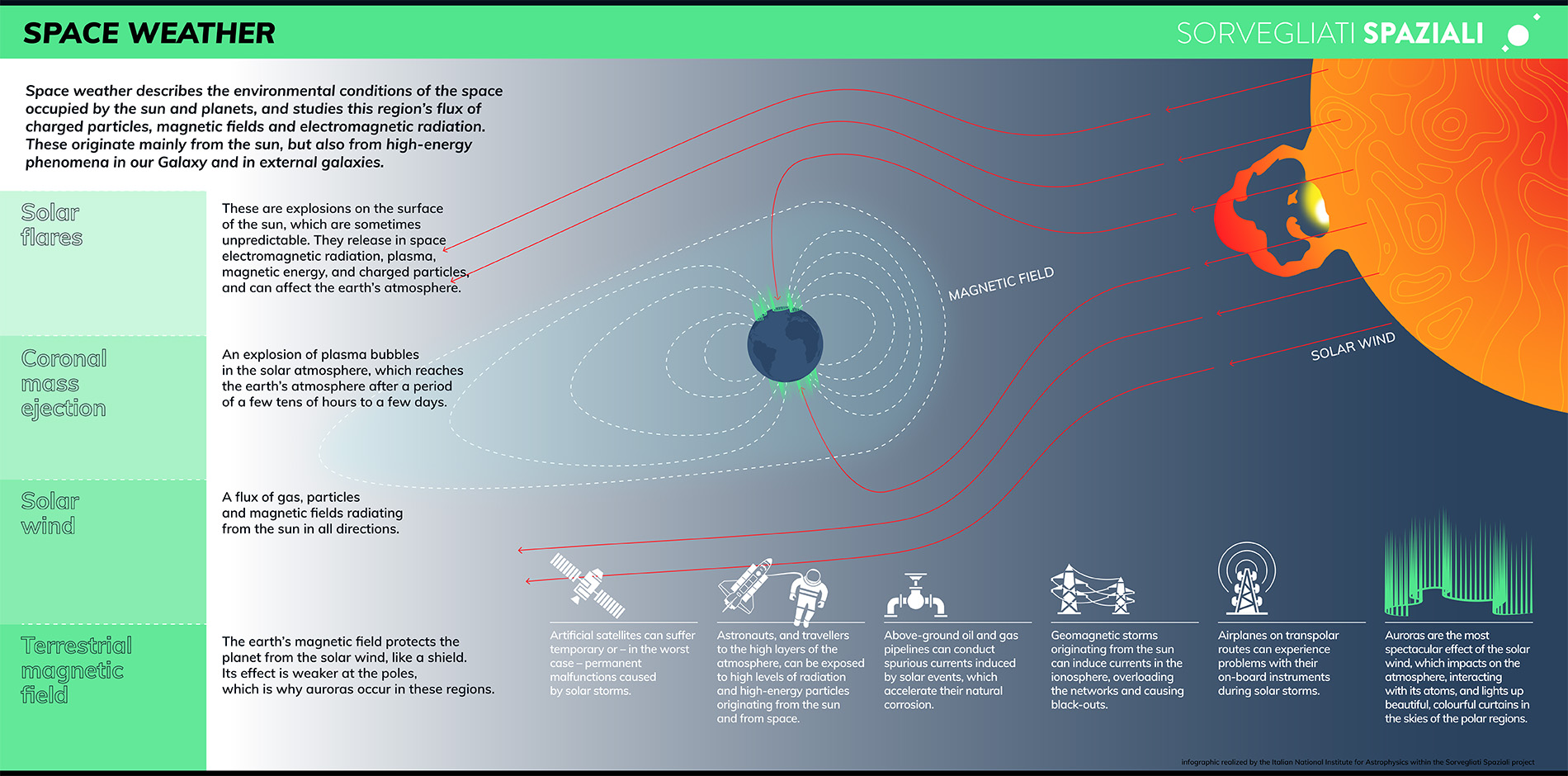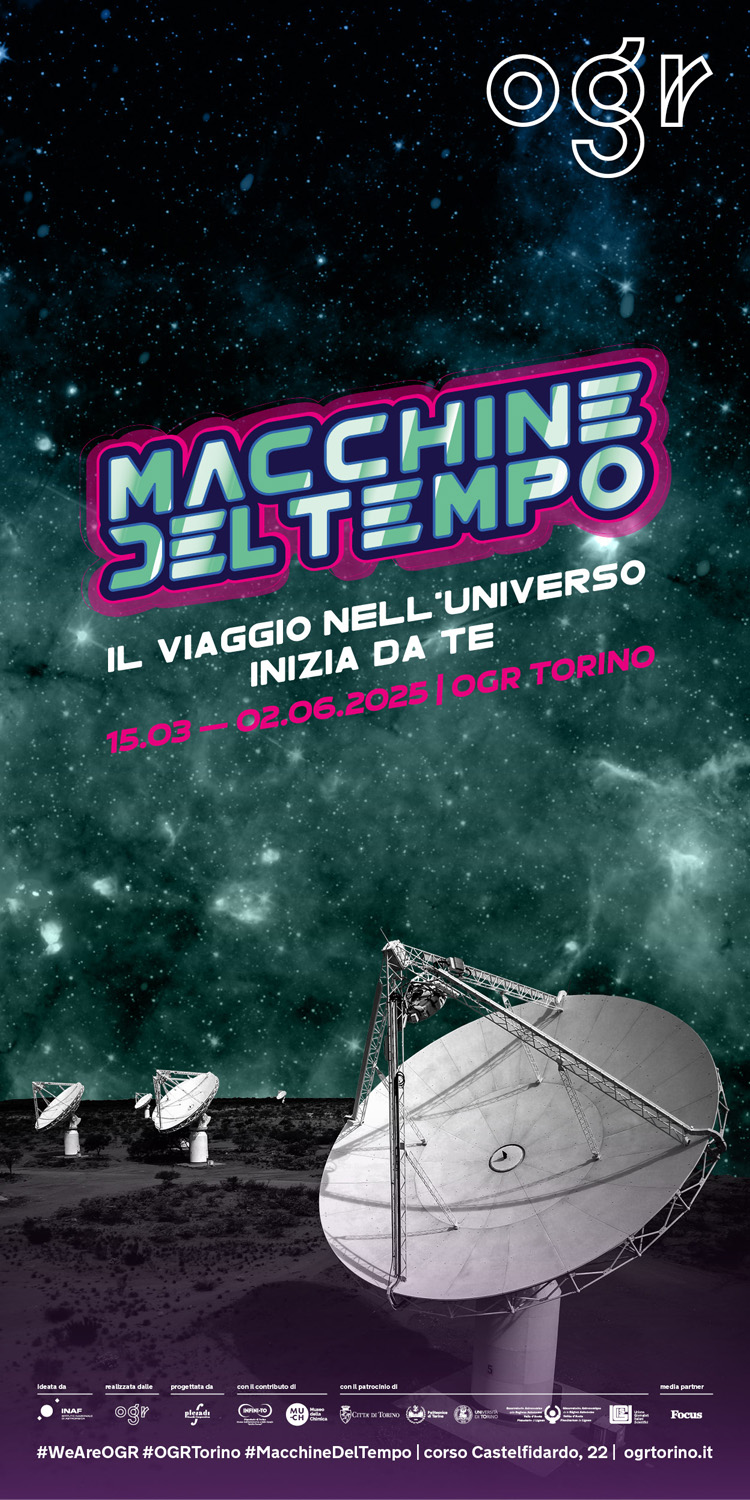Space
weather
“Space weather” describes the environmental conditions of the immediate surroundings of the Sun and planet. It studies fluxes of charged particles, magnetic fields, and electromagnetic radiation in this region of space, which are produced by solar activity and by high-energy phenomena in our Galaxy and in other galaxies.
Monitoring of space weather, both from Earth and from space, produces models and predictions. This is very useful not just for science, but also for the public at large, because space weather phenomena can affect the functioning and reliability of technology on satellites and on Earth.
Download the infographic by clicking here.
Alla scoperta di Solar Orbiter in dieci minuti
Video by Media Inaf, with an interview to Daniel Müller, solar physicist at the European Space Agency (Esa) and project
SpaceWeather.com, where it all started
Are you keen on auroras, and want to know where and how to observe them? Would you like to know
Specifically
“Space weather” describes the physical state of the space surrounding the earth and planets of the solar system, which is permeated by the solar wind. This is a continuous flux of electrically charged particles (or “plasma”), which is confined by the similar “interstellar wind” within a huge bubble called heliosphere. The sun is a stable, middle-aged yellow dwarf star which is about 5 billion years old. As it rotates, it transforms the weak magnetic field produced by its internal dynamo into strong magnetic fields emitting from the solar spots. The amount of solar spots characterizes the sun’s activity cycle, on a period of about 11 years. A scarcity of solar spots indicates that the sun is in a phase of low activity. Conversely, a high number of spots tells us that the sun’s activity is very strong. This characteristic derives from the fact that solar spots can release magnetic energy during the so-called “flares” emitted by the chromosphere, accompanied by particle acceleration and by the emission of electromagnetic radiation, ranging from X-rays to radio waves. Huge “plasma bubbles” (coronal mass ejections, or CME) are accelerated towards the planets. If a planet has a magnetic field which acts as a shield against particles from space, the field is compressed and magnetic storms ensue.
On earth, polar auroras are observed, as delicate, multicolor tapestries. They shine because the atoms and molecules of the atmosphere are excited by solar particles that pass through the magnetic shield. This phenomenon occurs also on other planets of the solar system, such as Jupiter and Saturn. The perturbations in the ionosphere influence the quality of radio transmissions, and create difficulties for the use of, for example, Gps systems. In addition, intense electric currents in the ionosphere can induce strong additional currents in power lines, causing electrical blackouts. Planes flying on polar routes can be hit by dangerous amounts of ionizing radiation and experience problems with their on-board instruments. During solar storms, astronauts performing extra-vehicular activities could absorb strong amounts of radiation, and satellites can suffer temporary, or in the worst case permanent, malfunctions, caused by solar and cosmic particles (cosmic rays) that interfere with their electronic equipment.
Space weather also concerns the study, modelling, and forecast of space meteorology, using data from space and earth-bound observatories. Space meteorology is a fairly new subject, concerning the weather in the entire heliosphere, which is determined not just by the Sun star, but also from high-energy phenomena occurring throughout our galaxy, or even in external galaxies. The flux and energy distribution of cosmic rays, in fact, is related to the evolution of close and distant populations of supernovae, while gamma-ray bursts (GRB) are caused by processes such as those occurring in hypernovae stars, or in stars with exceptionally strong magnetic fields (magnetars). These phenomena require long and difficult studies, which aim to build an experimental and interpretative scenario for space climate, considered the long-term evolution of space weather.
Space weather monitoring is based on observations from earth and from space, but at present the observing network is not large enough to provide a global coverage with the required detail. This lack of a strong infrastructure also limits the development of consolidated operational models for the forecasting of perturbations. Therefore, for several phenomena instantaneous observations (nowcasting) have to suffice, while the prediction (forecasting) of the sun’s activity cycle, flares, and CME remains in the early stages of development, despite the use of sophisticated methods based on long-term observations and on artificial neural networks.
INAF’s role
Within INAF there are competences in the development of models for analysis and forecasting, and observational infrastructures that contribute since many years to the understanding of space weather phenomena, through monitoring and interpretation.
The data acquired daily by INAF include high-resolution solar images, and measurements (made at the Svirco neutron monitor) of the cosmic ray flux reaching earth, within the Space Situational Awareness (SSA) network of the European Space Agency (ESA).
INAF also has the lead responsibility of the Antarctic node of the international Super Dual Aurora Radar Network (Superdarn). This node is located on Dome C in Antarctica, and measures the physical conditions of the ionosphere almost in real time. In addition, the 32m single-dish radiotelescope at Medicina has produced its first images of the sun at 24 GHz, which will be followed by those from the Sardinia Radio Telescope and from the Noto radio station in Sicily. These three instruments form thus an integrated observational network to monitor solar radio weather in the available time windows.
Lastly, a team of INAF researchers have recently released SWELTo, an on-line platform for the development and testing of new tools for the diagnostics of solar and interplanetary plasmas, and for the forecasting of the time of arrival and possible impact on earth of solar disturbances.
Other earth-based instrument dedicated to monitoring solar radio emission (Solar Radio Weather) in the 1-19 Ghz band are the Trieste Solar Radio System 2.0 (TSRS 2.0) and the Rende Solar Radio System (RSRS), which will become operational at the end of 2021 and at the beginning of 2022, respectively. And in space, the Solar Monitor of the Italian AGILE satellite is capturing high-energy emissions from solar flares.
For further informations take a look at Friends’ sites.


